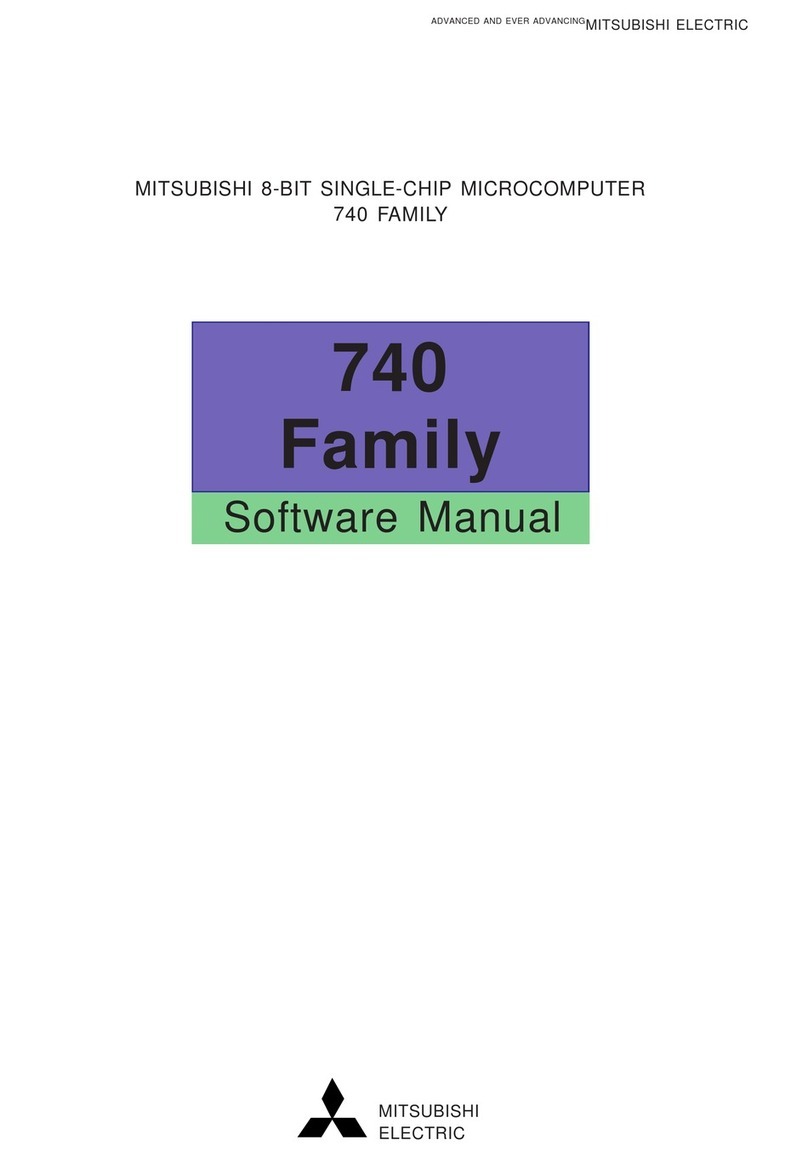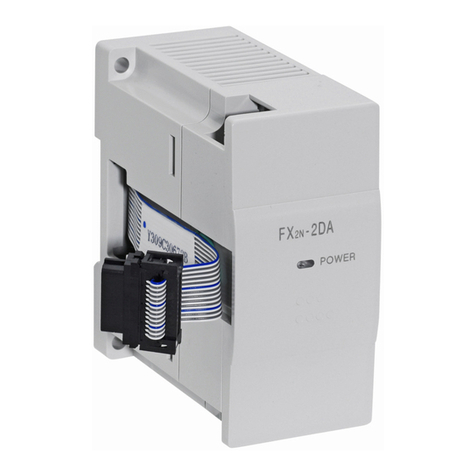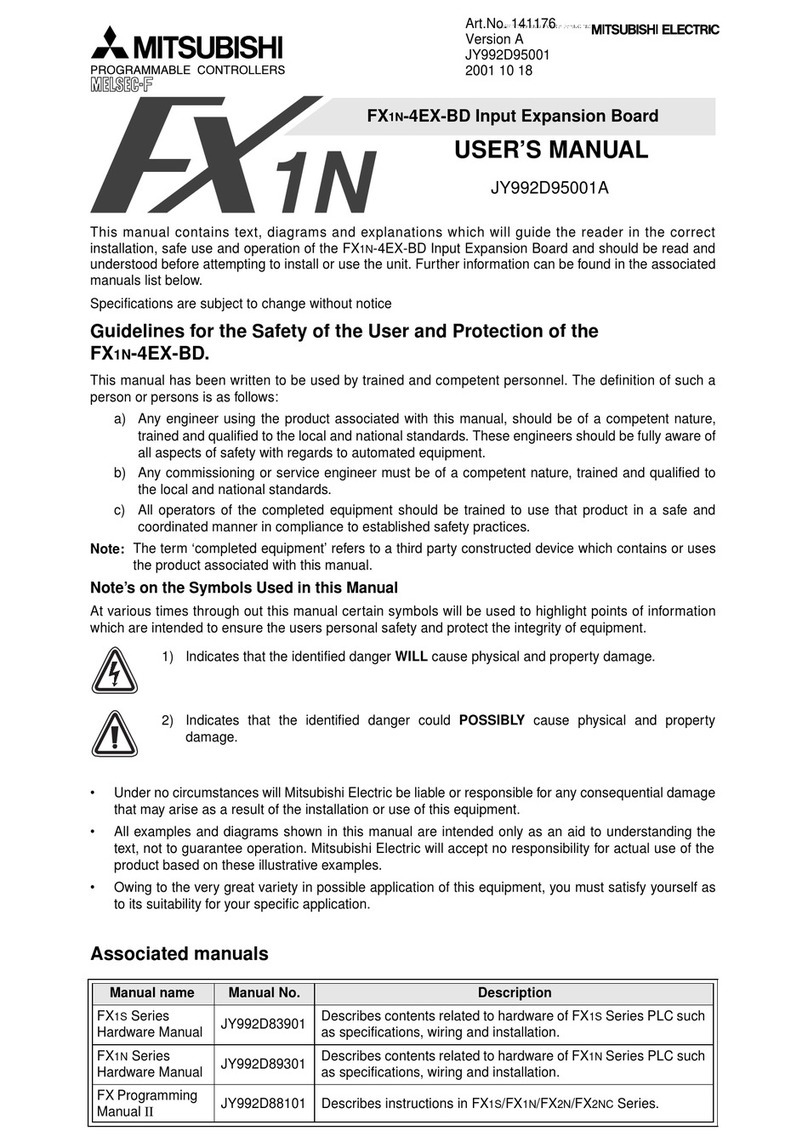
FX1N-2AD-BD Analog Input Expansion Board
User’s Manual
JY992D96201A
This manual contains text, diagrams and explanations which will guide the reader in the correct
installation, safe use and operation of the FX1N-2AD-BD Analog Input Expansion Board and should be
read and understood before attempting to install or use the unit. Further information can be found in the
associated manuals list below.
Specifications are subject to change without notice
Guidelines for the Safety of the User and Protection of the
FX1N-2AD-BD Analog Input Expansion Board.
This manual has been written to be used by trained and competent personnel. The definition of such a
person or persons is as follows:
a) Any engineer using the product associated with this manual, should be of a competent nature,
trained and qualified to the local and national standards. These engineers should be fully aware of
all aspects of safety with regards to automated equipment.
b) Any commissioning or service engineer must be of a competent nature, trained and qualified to
the local and national standards.
c) All operators of the completed equipment should be trained to use that product in a safe and
coordinated manner in compliance to established safety practices.
Note: The term ‘completed equipment’ refers to a third party constructed device which contains or uses
the product associated with this manual.
Note’s on the Symbols Used in this Manual
At various times through out this manual certain symbols will be used to highlight points of information
which are intended to ensure the users personal safety and protect the integrity of equipment.
1) Indicates that the identified danger WILL cause physical and property damage.
2) Indicates that the identified danger could POSSIBLY cause physical and property
damage.
• Under no circumstances will Mitsubishi Electric be liable or responsible for any consequential damage
that may arise as a result of the installation or use of this equipment.
• All examples and diagrams shown in this manual are intended only as an aid to understanding the
text, not to guarantee operation. Mitsubishi Electric will accept no responsibility for actual use of the
product based on these illustrative examples.
• Owing to the very great variety in possible application of this equipment, you must satisfy yourself as
to its suitability for your specific application.
Associated Manual
¤Indispensable manual
Manual Name Manual
Number Description
FX1S Series
Programmable controllers
Hardware Manual JY992D83901 Describes contents related to hardware of the
FX1S series PLC, such as specifications, wiring
and installation.
FX1N Series
Programmable controllers
Hardware Manual JY992D89301 Describes contents related to hardware of the
FX1N series PLC, such as specifications, wiring
and installation.
¤
FX Series of
Programmable controllers
Programming Manual ΙΙ JY992D88101 Describes instructions in FX1S/FX1N/FX2N/FX2NC
series.
1. Introduction
The FX1N-2AD-BD analog input expansion board (hereafter called “2AD” or “expansion board”) is to be
installed in an FX1S or FX1N series PLC, to increase the analog input by 2 points.
1.1 Features of 2AD
1) Analog input of two points can be increased using 2AD. If a 2AD is used, internal mounting in the top
of the PLC means that there is no need for a change to the installation area of the PLC.
2) Voltage input (0 ~10V) or current input (4 ~ 20mA) for analog to digital conversion can be set by
switching the auxiliary relays assigned to each channel.
Moreover, a digital value after conversion of each channel is stored in special data register allocated
to each channel, as shown in the table below.
However, the analog to digital conversion characteristic cannot be adjusted.
1.2 External Dimensions and Each Part Name
Dimensions: mm (inches) Accessory: Top cover for board ×1,
M3 self-tapping screw ×3 (to fix top cover ×1, to mount board ×2)
a) Terminals to connect analog module
The top face of this terminal block is higher than the top face of the
panel cover of the programmable controller by approximately 7mm
(0.28").
b) Mounting holes (2- ∅4.0 / 0.16")
c) Connector for PLC
1.3 System Configuration
• Only one expansion board can be used on one FX1S and FX1N PLC main unit.
Do not try to install two or more expansion boards. (They will not function)
• The 2AD cannot be used with a FX1N-EEPROM-8L or FX1N-5DM.
1.4 Applicable PLC
Table 1.1: Allocated Device
Device Description
M8112 Switch of input mode of Ch1 flag
OFF: Voltage input mode (0 ~ 10V)
ON: Current input mode (4 ~ 20mA)
M8113 Switch of input mode of Ch2 flag
OFF: Voltage input mode (0 ~ 10V)
ON: Current input mode (4 ~ 20mA)
D8112 Digital value of Ch1
D8113 Digital value of Ch2
Table 1.2: Allocation Terminal
Terminal name Content
V1+ Voltage input terminal for channel 1(Ch1)
I1+ Current input terminal for channel 1(Ch1)
V2+ Voltage input terminal for channel 2(Ch2)
I2+ Current input terminal for channel 2(Ch2)
VI- Common terminal for each channel
Table 1.3: Applicable Programmable Controller
PLC Type Applicable version
FX1S series V2.00 or later
FX1N series V2.00 or later
I2 +V1+ V2+I1 + V I-
38.5(1.52")
43(1.69")
a)
b)
c)
b)
2. Specifications
2.1 General Specifications
Same as the programmable controller main unit. (Refer to the programmable controller main unit manual)
2.2 Power Supply Specifications
Power supplied by internal feed of the programmable controller main unit.
2.3 Performance Specifications
3. Installation
Caution:
• Cut off all phases of power source before installing / removing or performing wiring work
on the master in order to avoid electric shock or damage of product.
• After the installation and wiring etc. replace the PLCs top cover before power ON.
Note:
• Securely install the expansion board, and fix to the PLC. Defective contact can cause
malfunction.
• The tightening torque for fix the board or top cover is 0.3 ~ 0.6 Nžm. Tighten securely to
avoid malfunction.
Note:
Only one expansion board can be used per main unit of FX1S and FX1N PLC. Do not try to
install two or more expansion boards.
Moreover, the 2AD cannot be used with the FX1N-EEPROM-8L or the FX1N-5DM.
The following is a generic explanation of how to install a expansion board to
the PLC.
a) Top cover for expansion board
b) M3 self-tapping screw to mount expansion board
c) M3 self-tapping screw to fix top cover
d) External port for optional equipment
e) Expansion board
Note: Do not remove this screw.
1) Remove the top cover of the main unit an keep.
2) Plug expansion board “e)” into the external port “d)”.
3) Fix expansion board to main unit using M3 self-tapping screws “c)”. (Tightening torque: 0.3 ~ 0.6N⋅m)
4) Attach top cover for expansion board “a)” removing section “a)’” to expose connector etc.
5) Secure top cover with M3 self-tapping screw “b)”. (Tightening torque: 0.3 ~ 0.6N⋅m)
Table 2.1: Performance Specifications
Item Specification
Voltage input Current input
Range of analog
input DC 0 ~ 10V (input resistance 300kΩ)
Absolute maximum input: -0.5V, +15V
DC 4 ~ 20mA (input resistance 250Ω)
Absolute maximum input: -2mA,
+60mA
Digital output 12bit binary
Resolution 2.5mV (10V /4000) 8µA {(20mA - 4mA) /2000}
Integrated
accuracy ±1% Against the full scale
(0 ~ 10V: ±0.1V) ±1% Against the full scale
(4 ~ 20mA: ±0.16mA)
A/D conversion
time 1 scan time (The analog to digital translation is done by the END instruction).
Input
characteristics
Insulation No insulation between each channel or the PLC.
Occupation point 0 points (2AD is not subject to the standard maximum number of control points in
the host PLC, as it operated via data registers).
Digital
output
Analog input
0 10V
4000
Analog input
020mA
2000
4mA
Digital
output
e)
d)
c)
a)a)' b)
c)
Note)





































